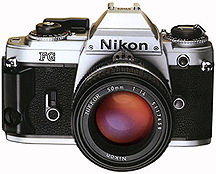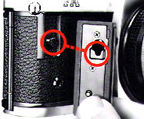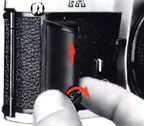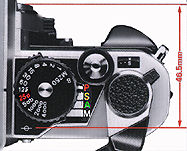Detachable Handgrip
 |
While not many Nikon bodies has a detachable hand grip design before the FA, I recalled that the Nikon FG was the first of such Nikon. The Nikon F3's hand grip was too shallow for a comfort hold due to its design of not to obstruct with the attachment of the MD4. The FA's handgrip somehow has a taller dimension. Thus, you can say it was much improved than the F3's. It does not only provide a steady shooting but also fits comfortably in your hand for a firmer grip onto the camera. |
Unfortunately, there are compromises: when shooting with a motor drive (*MD-15 and MD-12), you have to remove the grip first before such attachment can mate with the body. To do this, insert a coin into the slot, turn the screw counterclockwise until it loosens, then slide the grip down until it separates from the body. To re-attach. align the grip attachment screw with the inner hole in the handgrip, slip the grip up until it stops, then screw clockwise until it becomes tight.
 |
 |
Film Plane
Indicator
 |
To measure the exact distance between the subject and film plane, use the Film plane indicator which indicates the exact position of the film plane inside the camera. The distance between the film plane and the lens mounting flange is exactly 46.5 mm. This is standard on almost all Nikon SLR. Today's convenience of close up photography made this features less and less important. But nevertheless the indicator is here for you to refer for precise measurement, just in case you need it. |
Some Information on the LCD (Liquid Crystal Display).
![]()
The Nikon F3 was the first
Nikon body to have a LCD display in the viewfinder. Nikon claimed a life span
of approx 8 years. But I have used the F3 for the last 15 years and haven't
had any problem with it. Anyway, Nikon never clarifies how long does the LCD
in the FA lasts. While it is also a user's duty to keep the LCD in top working
order and prolong its life span, just note the following:
At high
temperatures (over approx. 60°C); the whole surface might turns black (While I
experienced purple color), so the exposure information can be very difficult
to read. However, this situation will return to normal when the temperature
drops. Avoid storing the camera in excessively hot places, such as in a car
parked in direct sunlight or inside the trunk. You may shorten the LCD's life
by doing so. When the temperature goes below freezing, the response time
decreases as the liquid crystal becomes more viscose.
| Previous |